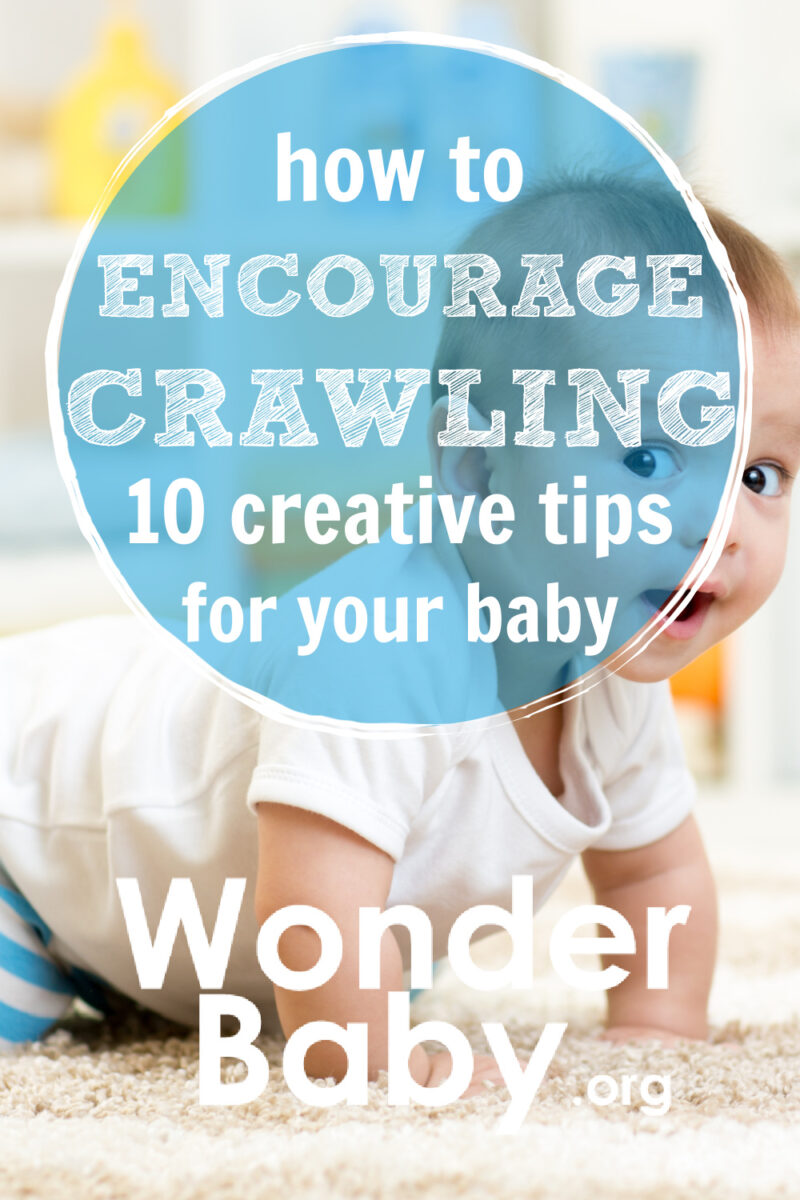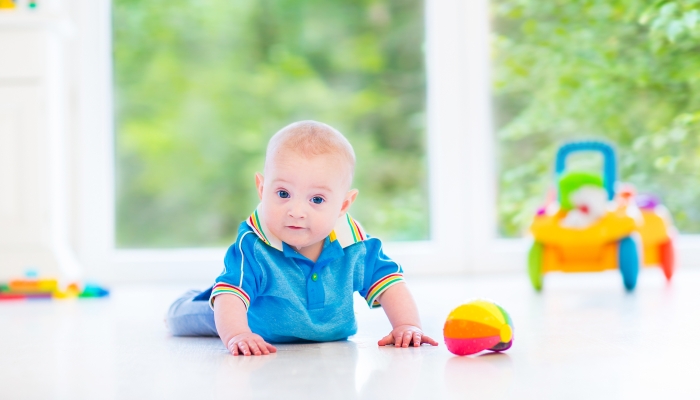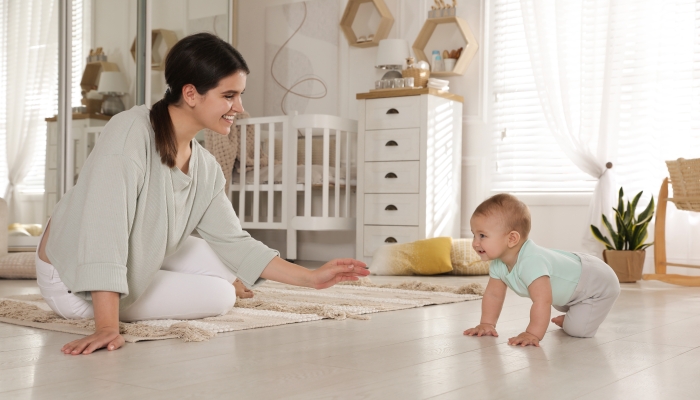How To Encourage Crawling: 10 Creative Tips for Your Baby

- Tummy time is one of the greatest forms of encouragement you can give to your baby as she learns how to crawl.
- Babies require playing on their tummy in their first 6 months of life.
- Even in short spurts, tummy time allows babies to practice the skills needed for crawling.
- As your baby becomes more mobile, it’s important to provide safe spaces for her to explore by childproofing your home.
- The age that babies start to crawl depends on several factors: motor skills, muscle strength, exposure to tummy time, motivation, and developmental readiness.
Your little bundle of wonder is becoming increasingly curious about her surroundings. With those powerful motor skills added to her arsenal, she wants to explore! Empower her by providing plenty of safe opportunities that encourage your baby to crawl.
There are many valuable benefits and skills connected to crawling. Crawling strengthens hands, wrists, shoulders, and core muscles as babies begin to support their body weight. They also learn how to coordinate their limbs to initiate movement across the floor.
These abilities can help your child accomplish things such as climbing, getting dressed, and holding writing instruments in the future.
Though it may surprise you, some babies skip crawling altogether. They may find other ways to get around that they find more rewarding than crawling. There is a lack of evidence suggesting that there are negative long-term consequences for skipping this milestone.
It’s important, however, to keep track of your baby’s milestones and ask the doctor to perform a screening if you are concerned about your baby’s development.
As with all milestones, your baby will determine when she’s ready to crawl. You can also bet that she’ll claim her personal crawling style. Babies can get creative with their method of locomotion. Keep up the encouragement, and keep your camera handy. She’ll be on the move before you know it!
What’s the Average Age to Start Crawling?
Most babies learn to crawl when they’re between 6 and 11 months. By 8 months of age, approximately 50% of all babies begin to crawl.
What Are the Signs a Baby is Ready to Crawl?
When your baby is ready to crawl, she may begin showing one or a combination of these signs:
- Rocking back and forth or side to side while on hands and knees
- Focusing on objects across the room
- Pivoting
- Holding up body on hands and knees
- Sitting up without support
- Moving forward on belly or on hands and knees
- Sliding backward while attempting to move forward
What Promotes Crawling?
Babies have an innate desire to move. It’s a matter of practice, motivation, and developmental readiness that will manifest this desire. Reflexes also play a significant role in the preliminary stages of crawling.
During tummy time, babies learn to integrate reflexes as they learn to crawl. For instance, babies tend to shoot out their arms as a protective response when they lose their balance. This reflex teaches babies how to transition from sitting to a crawling position.
Establishing a strong hand preference also promotes crawling. While demonstrating crawling readiness signs (i.e. rocking back and forth on hands and knees), your baby may move forward with her preferred hand.

How Can I Encourage My Baby to Crawl?
Some babies just can’t wait to start moving. Others may need a bit of encouragement. Here are 10 creative tips on how to encourage your baby to crawl:
1. Make time for tummy time every day.
Think of tummy time as a workout session for your baby. On her tummy, she builds her neck, shoulder, and back muscles. Your baby also learns how to hold up her head and shoulders. These muscle-building exercises also allow your baby to experiment with her arms and legs while on her tummy.
Designate a clear, safe space for tummy time. A crawling mat may be helpful if you have hard floors. Spending time on their belly provides physical and cognitive benefits for your baby, including sensory play.
All of this exercise and these sensations are quite stimulating for babies. Keep the atmosphere light and fun, and mix in frequent breaks to avoid having an overstimulated baby.
Be sure to reserve tummy time for wake time and adult supervision only. Be watchful for signs of sleepiness while your baby’s on her tummy. Keep her safe by always placing her down on her back to sleep. The ideal time to place your baby on her tummy is when she is well-rested, fed, and in a good mood.
2. Dress for the occasion.
Dress your baby in stretchy but fitted clothes. Loose material can obstruct your baby’s movements. Bare arms and legs may allow your baby to experience different textures of the floor and rug.
If the temperature is cold, crawling pants and socks may be helpful. While keeping your little one warm, these specially designed clothes with anti-slip grips prevent slipping and sliding on hard floors.
3. Go low.
Get down on the floor and lie on your belly while you face your baby. Make eye contact with her and smile. This will encourage her to lift her head. As her muscles strengthen, she may attempt to approach you.
Your baby’s first few attempts to reach you may send her backwards! She’s still developing the strength and motor skills to move forward. Here’s a solution: provide resistance. Place a pillow or your hands under your baby’s feet to allow her to push against them.
4. Tempt your baby with toys.
If your baby’s showing signs that she’s ready to crawl, toys may also be an option. Set them in front of your baby just beyond her reach, and see what she does! A crawling tunnel is another fun way to pique your baby’s interest.
Try to resist the temptation of moving a desired object closer into her grasp. You may not have to teach your baby how to crawl, but you can provide her with opportunities for problem-solving. This will encourage her to wiggle, roll, and eventually crawl to get what she wants.
5. Lie down together, tummy-to-tummy.
Some babies aren’t very enthusiastic about tummy time. If your baby finds it challenging, lie down and place your baby on your belly. The closeness of your body may intrigue her to lift her head and look at your face.
6. Let your baby check herself out.
Place a mirror on the floor facing your baby. She may be so curious about her reflection that she’ll want to move closer for a better look.
7. Lead by example.
Let her watch you crawl! Older siblings can also join in and demonstrate. Babies learn a great deal through observation. She may look at you with a bewildered expression at first, but you’ll definitely get her attention (and maybe even get her to giggle).
8. Knead those rolls.
Give your baby an invigorating massage to promote blood flow into her growing muscles. Regular massages will also help your baby become aware of her body and ease impending gastrointestinal issues, including gas and constipation.
9. Limit time on the bouncer.
Bouncers and baby jumpers can provide entertainment for your baby while you get a much-needed break. Excessive use, though, may delay your baby’s development. Your baby may learn to rely on the support of these devices rather than on her muscles to support her weight. Keep your baby’s bouncer and jumper sessions up to 15 minutes and no more than twice per day.
10. Strike a pose.
Doing yoga with your baby facilitates bonding time as well as body awareness (and don’t forget fun). Your baby can stretch and build her muscles. She can also benefit from the repetitive motions of yoga, which can aid in her crawling.

Childproofing Tips
As babies gain mobility, they can encounter potential hazards in their path.
When you have child-safety devices in place, you can enjoy peace of mind while witnessing your baby learn to crawl.
Protect your little one by installing these safety devices in your home:
- Safety gates on stairways and in entryways where your baby isn’t permitted to enter.
- Window guards and safety nets—bear in mind that window screens do not prevent children from falling out.
- Safety latches and locks on cabinets and drawers. Doing this will prevent your baby from accessing dangerous materials, such as medicine, household cleaners, and sharp objects.
- Bumpers on corners and edges to protect your baby from getting electrocuted
- Outlet covers and plates—look for types that children can’t pluck out.
- Cordless window shades to prevent strangulation. Long window shade cords can easily wrap around children’s necks.
- Anchors for furniture and appliances to avoid tip-overs. Babies may pull themselves up on bookcases or television stands. If they’re not anchored down, these heavy objects may fall on them.
- A fence (at least 4 feet tall) that surrounds your pool. Include gates that self-close and self-latch.
A note on stairs: Allowing your baby to learn how to navigate the stairs can be a valuable gift to her and your peace of mind. Instead of keeping the stairs off-limits, allow your baby to climb up and explore. Spot her as she climbs up and finds a way down the stairs. Your baby will acquire skills needed for crawling as well as for climbing and problem-solving.
What Should I Do If My Baby Doesn’t Start Crawling?
Babies have their reasons for doing—and sometimes not doing—things. If your baby’s reaching other developmental milestones, such as rolling over or showing curiosity, it may not be an issue. Here are a few reasons your baby may not be crawling yet:
- She’s wearing restrictive diapers. Make sure your baby’s diapers are snug, but not too tight. If the leg or tummy areas are too tight, they may be hindering your baby’s movements.
- She’d rather observe. If your baby isn’t feeling ready to crawl yet, she may prefer sitting and watching the world around her.
- She’s on the heavy side. Your baby might struggle with the weight she has to carry around.
- She hasn’t had enough opportunities. When babies are held too frequently, they lack the opportunity to discover ways to move their body.
You may want to reach out to your child’s pediatrician if you see these signs:
- Floppy arms and legs when picked up
- Low energy levels (after feedings and sleep)
- Doesn’t attempt to reach out to you or move towards objects
- Greatly favors one hand to grab objects
FAQs
Do babies crawl first or sit first?
It depends on your baby’s preference. Some babies start crawling on their bellies before learning how to sit.
Many babies can learn to crawl from a sitting position. When seated, assisted or unassisted, babies develop their neck and back muscles while holding up their head. Your baby may have a fortuitous moment where she leans over so far that she ends up in a crawling position.
Why do some babies skip the crawling stage?
Babies who skip the crawling stage may prefer other methods of movement. For instance, some babies may consider cruising as the most effective way to move around. They may go straight from cruising to walking.
Here are a few more reasons some babies skip the crawling stage:
- Upper body and core muscle weakness
- Hyper-sensitive sensory system (resists touching the floor with open hands)
- Lack of hand-eye coordination
- Lack of balance
- Inability to rotate hips
- Insufficient time on their tummy
- Lack of body and spatial awareness
What if my baby hates being on their tummy?
There are some reasons your baby may not be enjoying tummy time:
- She has yet to learn how to lift her head. A faceplant on the ground can’t be very comfortable.
- The floor is uncomfortable. Make sure the floor isn’t too cold or rough.
- She has gas. A belly full of gas can make tummy time seem like torture.
- She had previously spent too much time on her belly. Keep tummy time in short spurts.
Try these alternative positions to tummy time:
- Lap laying. Your baby may prefer the safety and warmth of your lap.
- Side laying. Lay your baby down on her side, and guide her arms in front of her. Provide extra support behind her with a bumper, such as a rolled-up towel.
- Carrying your baby tummy-down. Carry your baby facedown. Use your arms and hands to hold up her torso.

Related Posts

Crawling
Baby Hates Tummy Time? Try These Alternatives Instead!
If your baby hates tummy time, there’s hope! These 5 alternatives will keep your baby smiling while on their belly.

Crawling, Visual Impairment
When does a blind baby start crawling?
When does a blind baby usually start to crawl? When should I start to be worried that there is another issue besides blindness?

Crawling
Stages of Crawling: When and How They Happen
Your baby will learn to crawl in their own way and at their own pace. The crawling style your little one chooses will also influence when they start moving.